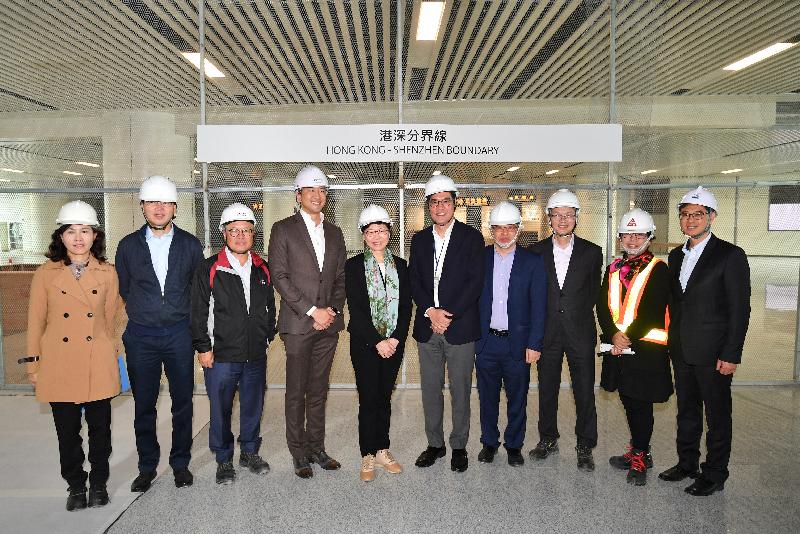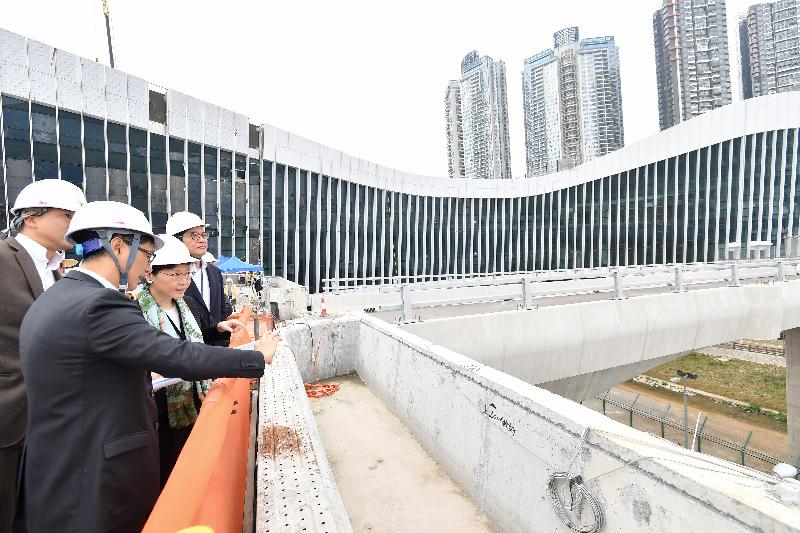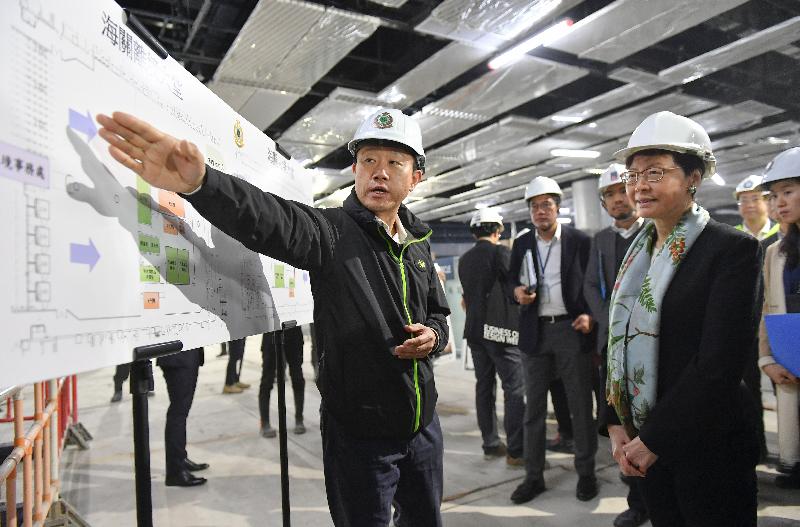The Chief Executive, Mrs Carrie Lam, accompanied by the Secretary for Development, Mr Michael Wong and the Under Secretary for Security, Mr Sonny Au, inspected the Liantang/Heung Yuen Wai Boundary Control Point (BCP) project this morning (March 14) to learn about the latest situation of the cross-boundary infrastructure.
Mrs Lam and the other officials first travelled through the connecting road linking the new BCP with the Fanling Highway. The connecting road named Heung Yuen Wai Highway is about 11 km long, which includes Lung Shan Tunnel and Cheung Shan Tunnel. The 4.8 km-long Lung Shan Tunnel is the longest road tunnel on land in Hong Kong. A number of unique engineering techniques had been adopted for the first time in Hong Kong during its construction, including the adoption of earth pressure balanced tunnel boring machine with a diameter of 14.1 metres to tackle the excavation challenges brought about by the ground conditions of the tunnel. When the tunnel boring machine completed southbound tube excavation, it made two 90 degree turns inside the underground cavern to continue work for the northbound tube. This innovative technique was used for the first time in Hong Kong, saving construction time, minimising impact on the environment and enhancing efficiency.
Mrs Lam and the other officials then visited the construction site of the Passenger Terminal Building of the new BCP to inspect the situation of works. They were briefed by relevant departments on the progress of the installation of facilities and equipment in the building as well as the future clearance arrangement. The specially-designed Passenger Terminal Building is the winning entry of the International Design Ideas Competition co-organised by the Hong Kong Special Administrative Region Government and the Shenzhen Municipal People's Government in 2010. The competition, with the theme "People Foremost, a Vista of New Connection", sought to blend the structures on both sides of the boundary into the surrounding environment and present a consistent image and style, providing a seamless and comfortable feel for passengers during immigration clearance under the "separate location" arrangement at the Passenger Terminal Building .
"The new BCP will be the seventh land-based control point on the Shenzhen-Hong Kong boundary (note 1), and is the first port designed and constructed with the concept of providing direct access facilities for both passengers and vehicles. The public may take public transport, private cars or walk through the pedestrian subway to reach the new BCP for immigration clearance. The new BCP is designed to handle 17 850 vehicle trips and 30 000 passenger trips daily," Mrs Lam said after the inspection.
Currently all cross-boundary traffic going from the eastern New Territories to the eastern Shenzhen and Guangdong has to travel through busy local roads in Hong Kong and Shenzhen via the two existing boundary control points at Man Kam To and Sha Tau Kok. The new BCP will help re-distribute cross-boundary traffic among the land-based control points in the east. In addition, the dual two-lane Heung Yuen Wai Highway which links up with Fanling Highway interchange, via Sha Tau Kok Road, Ping Yeung and Lin Ma Hang Road interchanges, will improve traffic in the North District and alleviate the busy traffic conditions in the Sha Tau Kok and Ta Kwu Ling area.
The new BCP will connect with the Shenzhen Eastern Corridor to Longgang, reaching the eastern part of Guangdong Province via the Shenzhen-Huizhou Expressway (Huizhou-Yantian Expressway) or the Shenzhen-Shantou Expressway, providing a direct and efficient cross-boundary access between Hong Kong and eastern Shenzhen, Huizhou as well as eastern Guangdong, and enhancing the "one-hour living circle" in the Guangdong-Hong Kong-Macao Greater Bay Area.
According to works progress, Heung Yuen Wai Highway is in the final testing and commissioning stage and anticipated to be opened for use later this year to alleviate traffic in the North District. As for the construction of the new BCP, the follow-up equipment installation and testing works have commenced. The Government strives to complete the construction of the new BCP this year, and will continue the ongoing co-ordination with the Shenzhen Government to determine the commissioning schedule for the new BCP.
Note 1: Currently there are six land-based control points (BCPs) on the Shenzhen-Hong Kong boundary, of which Man Kam To, Sha Tau Kok, Lok Ma Chau and Shenzhen Bay are vehicular BCPs, while Lo Wu and Lok Ma Chau Spur Line are railway BCPs.
Follow this news feed: East Asia









